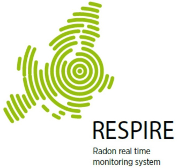Replicability potential evaluation and demonstrative case in Belgium (Action B4)
Several buildings have been characterized in order to evaluate the applicability of the RESPIRE SNAP remediation system and compare them to other
remediation techniques. The main idea was to select different type of buildings in different radon-potential and geological environments, since these are the
main external (non-building related) factors determining the optimized and best-suited remedial action. Different type of buildings (Dwellings/schools/offices) in different radon potential zones (high/moderate/low radon potential) and in different geological settings (soft-sediments, shale, karst) have been characterised for their radon entry dynamics and remedial potential. Very strong variations in radon concentration and entry rate of over 20000 Bq/m³ have been observed (Figure 1).

By installing a wind-driven aeolian fan on the roof that is connected to a sump in the basement, the radon concentrations have been drastically reduced to well below the reference level (Figure 2).

Several test with piloted ventilation have been carried out in different test houses. The results are promising as the fans are only activated when the radon
concentration increase. Figure 3 illustrates the functioning and the efficiency of the system.

concentration in the living spaces (‘haut’) below the reference level.
Another example from karst area indicates the dimensioning of the sub-slab extraction depends highly on the soil permeability, which can be extremely high in karst areas. In such cases, it can be efficient to pulse fresh air into the soil in stead of extracting air (Figure 4).

A permeability test before remediation can help in dimensioning the remedial system like the extraction rate, the type of fan to use:

Sometimes, extraction from the air in a basement or a crawl space can be a very efficient method of remediation. The first results are promising,
although the connectivity between the sensor and the fan can be a complication (transmission of a wireless signal or wired solutions).






